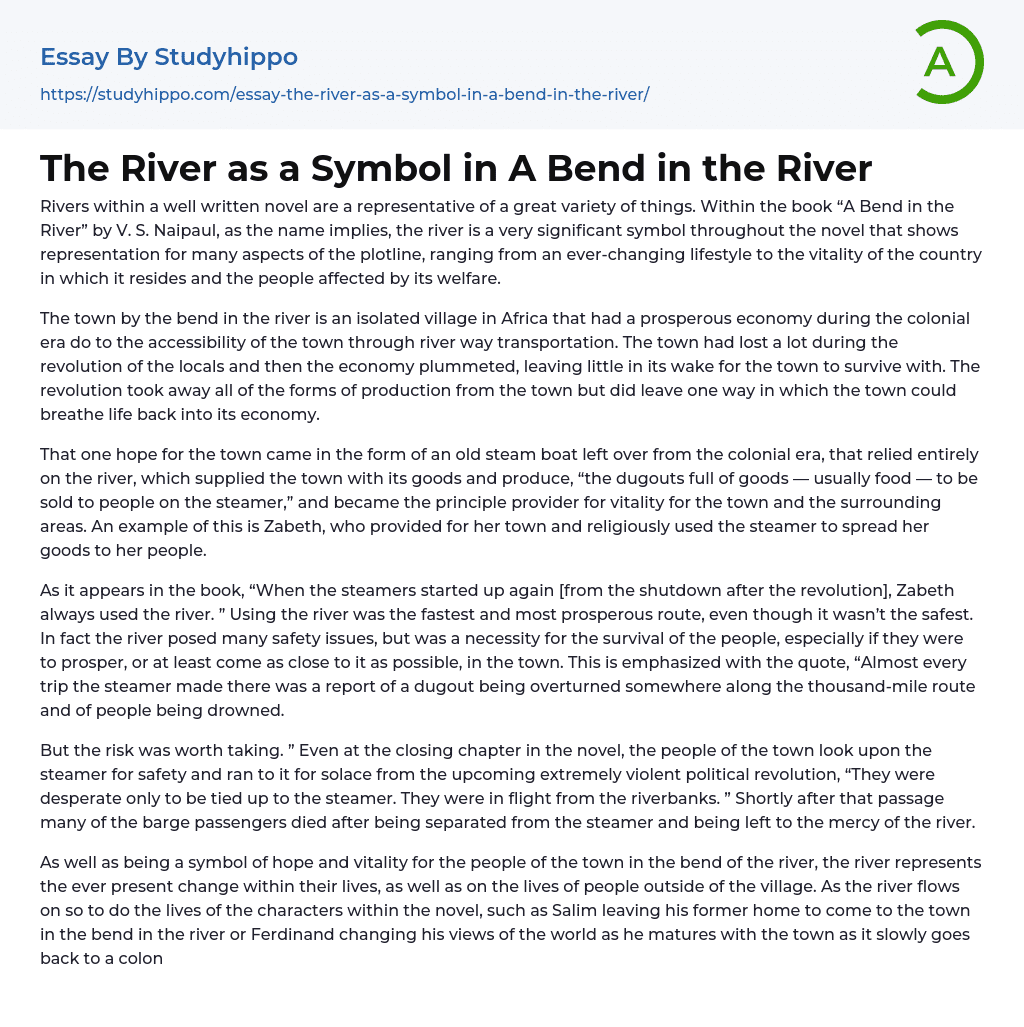
Rivers within a well written novel are a representative of a great variety of things. Within the book “A Bend in the River” by V. S. Naipaul, as the name implies, the river is a very significant symbol throughout the novel that shows representation for many aspects of the plotline, ranging from an ever-changing lifestyle to the vitality of the country in which it resides and the people affected by its welfare.
The town by the bend in the river is an isolated village in Africa that had a prosperous economy during the colonial era do to the accessibility of the town through river way transportation. The town had lost a lot during the revolution of the locals and then the economy plummeted, leaving little in its wake for the town to sur
...vive with. The revolution took away all of the forms of production from the town but did leave one way in which the town could breathe life back into its economy.
That one hope for the town came in the form of an old steam boat left over from the colonial era, that relied entirely on the river, which supplied the town with its goods and produce, “the dugouts full of goods — usually food — to be sold to people on the steamer,” and became the principle provider for vitality for the town and the surrounding areas. An example of this is Zabeth, who provided for her town and religiously used the steamer to spread her goods to her people.
As it appears in the book, “When the steamers started up again [from the shutdown after the
revolution], Zabeth always used the river. ” Using the river was the fastest and most prosperous route, even though it wasn’t the safest. In fact the river posed many safety issues, but was a necessity for the survival of the people, especially if they were to prosper, or at least come as close to it as possible, in the town. This is emphasized with the quote, “Almost every trip the steamer made there was a report of a dugout being overturned somewhere along the thousand-mile route and of people being drowned.
But the risk was worth taking. ” Even at the closing chapter in the novel, the people of the town look upon the steamer for safety and ran to it for solace from the upcoming extremely violent political revolution, “They were desperate only to be tied up to the steamer. They were in flight from the riverbanks. ” Shortly after that passage many of the barge passengers died after being separated from the steamer and being left to the mercy of the river.
As well as being a symbol of hope and vitality for the people of the town in the bend of the river, the river represents the ever present change within their lives, as well as on the lives of people outside of the village. As the river flows on so to do the lives of the characters within the novel, such as Salim leaving his former home to come to the town in the bend in the river or Ferdinand changing his views of the world as he matures with the town as it slowly goes back to a
colonial state.
With the flowing river it brings along its wake water hyacinths further showing change coming up during important parts of the novel such as the end of the story as barges tried to attach themselves to the leaving steamer, “Water hyacinths pushed up in the narrow space between the steamer and the barge. ” These are a visualization of the change in the river, such as foreshadowing the change from rebellious bush back into modern society, “from beyond the bend in the river, were clumps of water hyacinths, dark floating islands on the dark river, bobbing over the rapids.
It was as if rain and river were tearing away bush from the heart of the continent and floating it down to the ocean, incalculable miles away. ” This quote is the embodiment of representations of change as a symbol representing the slew of kafkaesque changes to come to the town, as a whole. Throughout the novel the river is a clear representation of many things. Hope, vitality, and change are all underlying themes within this one symbol within the novel written artfully by V. S. Naipaul to display the fluidity of life and to demonstrate the lack of tangibility within the ever changing world of colonial Africa.
- South Africa essays
- Nigeria essays
- Boo Radley essays
- Genesis essays
- Richard iii essays
- Alice in Wonderland essays
- On the road essays
- Ozymandias essays
- The Nightingale essays
- Holden Caulfield essays
- Animal Farm essays
- 1984 essays
- A Hanging essays
- Shooting An Elephant essays
- A Tale Of Two Cities essays
- Adventures Of Huckleberry Finn essays
- Arthur Conan Doyle essays
- Brave New World essays
- Characters In Hamlet essays
- Characters In Romeo And Juliet essays
- Desdemona essays
- Diary Of A Wimpy Kid essays
- First-Person Narrative essays
- Frankenstein essays
- Heart Of Darkness essays
- Jane Eyre essays
- Jay Gatsby essays
- King Duncan essays
- Librarian essays
- Little Red Riding Hood essays
- Lord Of The Flies essays
- Silas Marner essays
- The Cask Of Amontillado essays
- The Catcher In The Rye essays
- The Crucible essays
- The Handmaid's Tale essays
- The Reader essays
- Virgil essays
- Wuthering Heights essays
- Candide essays
- Castle essays
- J. D. Salinger essays
- Ulysses essays
- Ethan Frome essays
- In Cold Blood essays
- Outliers essays
- Tuesdays With Morrie essays
- The Art of War essays
- Wife of Bath essays
- Huckleberry Finn essays



